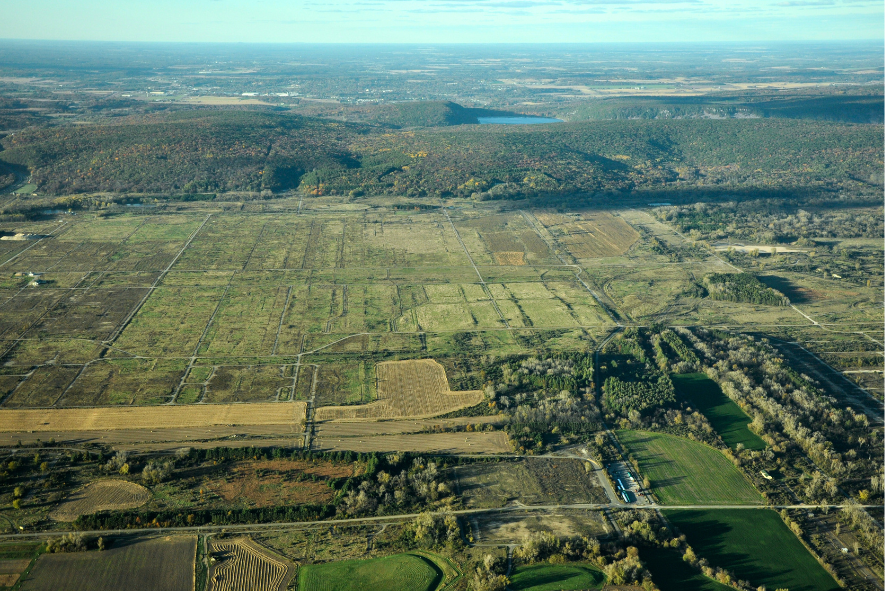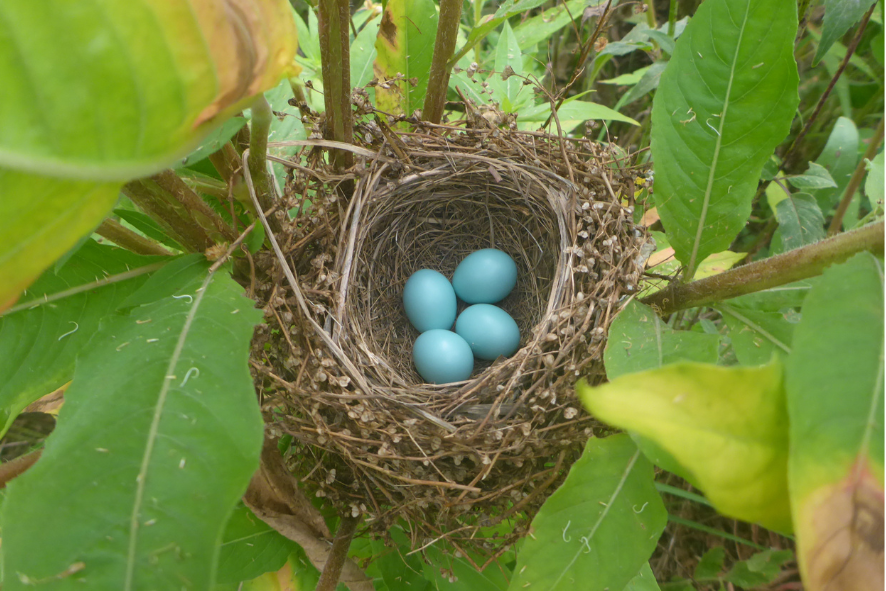A collaborative research effort is answering an important question: how are Wisconsin’s birds using restored grasslands?
The former Badger Army Ammunition Plant has a diverse community of grassland birds, including most of Wisconsin’s species that are in need of conservation. But what makes this place so special to them?
Here’s what four years of research at the former plant have discovered:
-
-
- the variety of both native and nonnative grasslands makes this bird diversity possible
- the site’s large size and connectedness fosters large populations and helps birds move readily from one area to another as conditions change
-
Mike Mossman, an ornithologist on this project, describes how birds respond to restoration in the guest blog below. This research was conducted by Mike along with Angus Mossman, Jeb Barzen, Lisa Hartman, and the Ho-Chunk Nation’s Sacred Earth reservation (Maa Wákącąk) manager Randy Poelma.

A prairie in the second year of its restoration on Ho Chunk Nation Land. This site was surveyed as part of the Bird Response to Restoration on the Former Badger Army Ammunition Plant project, funded in part by NRF. Photo by Mike Mossman
About the Badger Lands
Believe it or not, this beautiful patchwork quilt of quality bird habitat was once a huge industrial site.
Driving along Highway 12 between Baraboo and Sauk City, among the crop fields that were once part of the great Sauk Prairie, you might notice a 4-mile-long chain link fence. Behind it lies the vast (7,340-acre) former Badger Army Ammunition Plant.
Touted as the world’s largest when constructed in 1942, the plant produced propellants for 3 wars before closing in 1997. Nearly all of its buildings and many miles of roads, train tracks and steam lines have been removed. It’s left behind a complex legacy of lives lived and lost, displacements, contamination, transition and renewal.
After the plant shut down, the land was divided primarily into the Sauk Prairie State Recreation Area, the USDA Dairy Forage Research Center, and the Ho-Chunk Nation’s Sacred Earth Reservation, or Maa Wákącąk.
The new stewards are working to honor and heal the land. The Ho-Chunk Nation, Wisconsin DNR, and conservation organizations are restoring the prairie and oak savanna ecosystem that thrived here for millennia prior to Euro-American settlement. Or—given recent changes in climate and new nonnative species—something like it, something whole and resilient, that will provide for future generations of plants, wildlife, and people.

Aerial view of the Maa Wacacak grasslands in 2016, on former Badger Army Ammunition plant land, looking north toward Devils Lake. Photo by Mike Mossman
Studying birds at the Badger Lands
Birds are an important strand of the grand ecological web here at the Badger Lands, which has been designated as an Important Bird Area. Birds are particularly important in guiding our land management because they are easy to observe, well understood, and well loved. They are mobile and we see them responding quickly to changes in their habitat.
I have studied birds at the former ammunition plant since it closed—watching (and hearing!) how each species responds according to its habitat needs, as the land changes. For example, pasture was abundant here when the plant closed, but cattle were removed during deconstruction and the pasture grew into thick, tall grass. This reduced the numbers of western meadowlark, upland sandpiper and savanna sparrow, while it increased the numbers of Henslow’s sparrow. Then as invasive shrubs spread across the site, grassland species such as eastern meadowlark, bobolink and grasshopper sparrow declined. Shrub-loving species such as the yellow warbler and Bell’s vireo thrived. The Ho-Chunk Nation began to bring back open grassland by cutting and treating woody invasives, using prescribed fire, and planting native prairie. As a result, many grassland birds returned to Maa Wákącąk.
It is complicated to restore a naturally complex and dynamic ecosystem that will provide for an abundance and variety of native grassland and savanna birds. What land to burn and how often? Which native species to plant and which invasive species to focus on controlling?
The details of management really matter.

Henslow’s sparrow singing on Queen Anne’s lace, at Maa Wacacak. Photo by Andy Kraushaar
The land restoration details
For the past 4 years I have studied these details with Angus Mossman, Jeb Barzen, Lisa Hartman, and Maa Wákącąk manager Randy Poelma. We established 18 ten-acre plots in a variety of areas at Badger. On each, we made careful observations of the numbers and species of birds, and how they used the habitat throughout the nesting season from mid-May through mid-July. We also studied and compared the habitat, including the species and densities of grasses and prairie forbs, the amount of plant litter on the ground, and the amount of woody cover.
Then, we tracked the changes to both the habitat and the birds on each of these plots. Weedy, formerly industrial sites succeeded to grasses, cropland was planted to prairie, and woody plants invaded. We documented changes that occurred after sites were burned, or brush and trees were cut. Sites that had been planted to prairie over 20 years ago were included, and we monitored others as they developed from bare ground. Grass hay habitat was included, and even a wooded area.
Our team introduced university and local high school students to these studies, and they helped us out in the process.

Birds respond to land restoration – but how? Sauk Prairie High School student Angel Galvan conducts plant cover estimates as part of the project. Photo by Mike Mossman
What have we learned?
Plenty! Fire is an important part of the grassland ecosystem. It inhibits woody growth, and encourages lush growth of native plants. Because it is not applied annually, and varies in its intensity, it helps create a patchwork of habitats. This patchwork provides for a variety of nesting birds, which take advantage of native prairie, non-native grassland and oldfield, and combinations thereof.
Henslow’s sparrow is an example of a species with an intimate, dynamic relationship with fire. It needs thick tall grass with thatch on the ground for nesting. It usually leaves a site after the thatch is burned off, then it returns in increasing numbers in subsequent years. Although discouraged by fire in the short term, it benefits in the long term at Badger, for it is most abundant in sites that have a history of fire.
We also learned that variety is key. Interestingly, ways of managing the land that benefit one bird species we want to conserve may disfavor another. Certain species like open expanses, others like scattered trees, or patches of shrubs. Some like sites that have been recently burned, while others do not. There are some that prefer grasses, and others that prefer prairie forbs. The solution is to give them a variety of habitats to choose from.

Prescribed fire on Maa Wacacak. Photo by Mike Mossman
Surprising ways birds respond to restoration
For example, shrubby grasslands have the most species and highest numbers of birds. But most of these are common species that are fairly widespread across southern Wisconsin, and need little if any help. When you consider only the bird species that are in need of conservation, shrubby grasslands are not as important as the others we studied. And yet, they still provide well for a few shrub-loving species in need, like the Bell’s vireo and brown thrasher.
Another example is grass hay areas, which are not native but are very important habitats for several declining grassland species such as eastern meadowlark, grasshopper sparrow, bobolink and Henslow’s sparrow (when left uncut until August).

Dickcissel nest in evening primrose. Birds respond to restoration quickly, which makes them important to study. Photo by Angus Mossman
In a nutshell
Altogether, our studies show that the Badger Lands provide for a rich community of grassland, shrubland and savanna birds, including most of those that are in need of conservation effort in Wisconsin. This is due to its mosaic of suitable native and nonnative grasslands of different types and histories. And, to its large expanse and connectedness, where birds can move readily from one site to another as conditions change.
May this former ammunition plant forever remain a hardy and beautiful land full of bird song!
Thank you NRF for helping support our studies.

GUEST BLOGGER
Mike Mossman
Ornithologist and a longtime NRF Field Trip leader!
The Sauk Prairie Conservation Alliance contracted Mike Mossman, an ornithologist who has studied birds in Wisconsin for more than 45 years, for the portion of the study made possible by NRF members.
Supporting bird conservation
Thank you to NRF’s supporters who make work like this possible! Our members helped support this project’s second year of field work through our C.D. Besadny Conservation Fund.
Want to support bird conservation projects in Wisconsin? Join the Great Wisconsin Birdathon (April 15th through June 15th)!
Photo of Mike Mossman by Lisa Hartman.